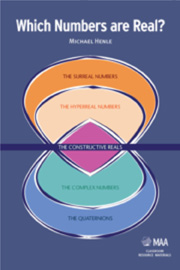Introduction
Summary
Alternative reality
The real numbers are fundamental. Although mostly taken for granted, they are what make possible all of mathematics from high school algebra and Euclidean geometry through the calculus and beyond, and also serve as the basis for measurement in science, industry, and ordinary life. In this book we study alternative systems of numbers: systems that generalize and extend the reals yet stay close to the fundamental properties that make the reals central to so much mathematics.
By an alternative number system we mean a set of objects that can be combined using two operations, addition and multiplication, and that share some significant algebraic and geometric properties with the real numbers. Exactly what these properties are is made clear in Chapter One. We are not concerned with numeration, however. A numeration system is a means of giving names to numbers, for example, the decimal system for writing real numbers. We go beyond numeration to describe number systems that include numbers different from ordinary numbers including multi-dimensional numbers, infinitely small and infinitely large numbers, and numbers that represent positions in games.
Although we present some eccentric and relatively unexplored parts of mathematics, each system that we study has a well-developed theory. Each system has applications to other areas of mathematics and science, in particular to physics, the theory of games, multi-dimensional geometry, formal logic, and the philosophy of mathematics. Most of these number systems are active areas of current mathematical research and several were discovered relatively recently.
- Type
- Chapter
- Information
- Which Numbers are Real? , pp. vii - viiiPublisher: Mathematical Association of AmericaPrint publication year: 2012



